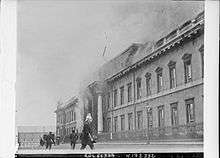Burning of the Custom House
| ||||||||||||||||||||||||||||||||
The Custom House, Dublin was occupied and then burnt in an operation by the Irish Republican Army (IRA) on 25 May 1921, during the Irish War of Independence. The Custom House was the headquarters of the Local Government Board for Ireland, an agency of the British administration in Ireland, against which the IRA was fighting in the name of the self-proclaimed Irish Republic. The operation, involving over 100 IRA volunteers, was a propaganda coup for the republicans but a military disaster for the IRA in the Irish capital. Five of its volunteers were killed (along with three civilians) and over 80 captured.[1]
Background
The Irish War of Independence was a guerrilla campaign by the IRA in support of the Irish Republic declared in 1919 and entered its bloodiest phase in the first six months of 1921. In Dublin a total of 309 people were killed in the conflict and several hundred more wounded.[2]
Dublin was garrisoned by over 10,000 British troops and 1,600 police including 400 men of the RIC Auxiliary Division.[3] Most IRA actions in the city consisted either of assassinations of selected police, military or administration figures by the Squad, or ambushes on British forces by one of the four Active Service Units of the IRA's Dublin Brigade (together comprising about 100 men). These were usually rapid and fleeting attacks using grenades and handguns, followed by a quick getaway. There were strict orders given to IRA units to avoid prolonged engagements with the better-armed British forces.
However this policy was reversed after an Irish cabinet meeting in May 1921 where the President of the Republic, Éamon de Valera, called for a spectacular public show of force by the IRA with which to reinforce the idea that it was an army representing an Irish government. For this reason it was decided to attack and burn the Custom House, which, although an important government building, was not defended by the British military. Michael Collins was against the attack but was overruled.[4]
The attack
In the early afternoon of 25 May 1921, roughly 120 non-uniformed IRA guerrillas or Volunteers began to gather around the Custom House in groups of twos and threes.[1] They belonged to the 2nd Battalion of the Dublin Brigade under Tom Ennis. Only a minority of these were experienced guerrilla fighters and they were armed only with pistols and a limited amount of ammunition. At 1pm, they rushed the Custom House and overpowered the police guard. A lorry pulled-up outside the building with tins of petrol and bales of cotton, which were then sprinkled throughout the building. The IRA Volunteers herded all the staff into the main hall. The caretaker of the building was shot dead when he tried to call the police.[1]
However, at about 1:10pm a watching policeman notified British forces and 60 Auxiliaries in three lorries and an armored car quickly arrived on the scene.[1] Four Auxiliaries were wounded in a gun battle with one of the IRA protection teams outside the building. The other company fired into the building with rifles and Lewis machine guns, exchanging fire with the IRA fighters inside. A number of IRA men and civilians were killed or injured by the Auxiliaries.[5] As fighting raged outside, IRA volunteers inside the building were ordered to set it alight.[1]
The ammunition of the IRA Volunteers quickly ran out and the firefight ended within 30 minutes. Some Volunteers were shot as they tried to run away. Tom Ennis, in command of the operation escaped but was hit twice in the leg. Many others were arrested along with civilians as they came out of the now burning Custom House with their hands up. The Fire Brigade, which had been delayed from responding by other IRA companies in the city, arrived too late to put out the fire.[1] British military forces composed of units from the Wiltshire Regiment arrived and took over the operation from the Auxiliaries at this point. A total of 111 people were arrested of whom 70–80 were IRA members.[6]
The Custom House burned for five days and was all but completely destroyed by the fire. With it were destroyed many centuries of local government records.[1] The Irish Bulletin, official gazette of the Irish Republic, reported:
A detachment of the Dublin Brigade of the Irish Army was ordered to carry out the destruction of the Custom House in accordance with a decision arrived at after due deliberation of the ministry of Dáil Éireann. We in common with the rest of the nation regret the destruction of historical buildings. But the lives of four million people are a more cherished charge than any architectural masterpiece. The Custom House was the seat of an alien tyranny.[1]
Aftermath
The operation was successful from a republican point of view in the sense of propaganda value but it was a heavy blow in terms of the numbers lost, both killed and arrested. The Squad and Active Service Units were amalgamated into the Dublin Guard. However, it did not disable totally the IRA's campaign in Dublin. The Dublin Brigade carried out 107 attacks in the city in May and 93 in June, showing a fall-off but not a dramatic one.[7]
The armed conflict was brought to an end on 11 July 1921 and negotiations were opened which would produce the Anglo-Irish Treaty in December of that year. The Custom House was re-built after the end of the war.
References
- 1 2 3 4 5 6 7 8 Today in Irish History - The Burning of the Custom House - The Irish Story
- ↑ Eunan O'Halpin, "Counting Terror", in, David Fitzpatrick Ed., Terror in Ireland 1916-1923. p152
- ↑ Sheehan, William. Fighting for Dublin, The British battle for Dublin 1919-1921. p125
- ↑ Dwyer, T Ryle. The Squad and the Intelligence Operations of Michael Collins. pp240-244
- ↑ Dwyer, pp244-248
- ↑ Sheehan, p53
- ↑ Hopkinson, Michael. The Irish War of Independence. p102
